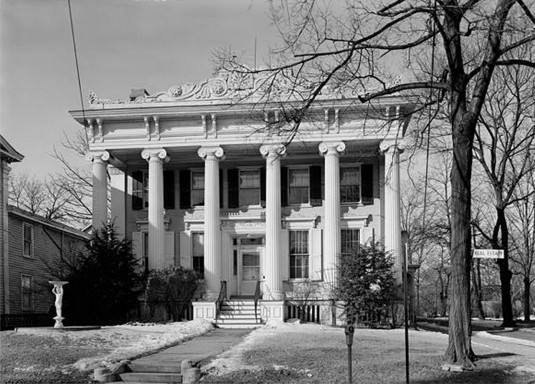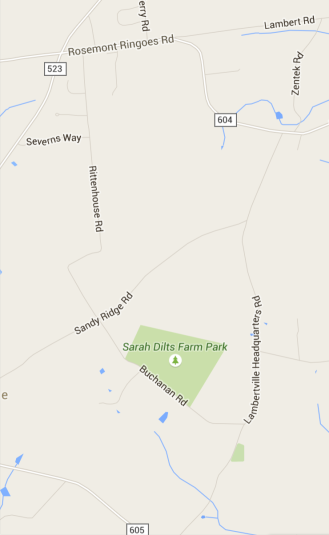
Beautiful, isn’t it? One of the most extraordinary buildings to be found in Flemington, a town with more than its share of great old buildings. It is an outstanding example of Greek Revival architecture.1
The families listed here are the ones whose names appear most often in my posts. The website has many other names of Hunterdon and old Burlington County families. Please use the search window to find what you are looking for.

Beautiful, isn’t it? One of the most extraordinary buildings to be found in Flemington, a town with more than its share of great old buildings. It is an outstanding example of Greek Revival architecture.1

There is an odd sort of road in Delaware Township, running south from Sergeantsville, that I have often wondered about. It is called Rittenhouse Road, and for much of its length, it runs straight as an arrow, then suddenly does a zigzag before ending at Sandy Ridge Road.
Quite often the very straight roads in Hunterdon County were created as a result of the early, large proprietary tracts that forced roads to run along their borders. But that is not the case here. This road ran through the middle of Daniel Robins’ 700+ acres, surveyed in 1722.
Feeding Fifty Men Was Not Uncommon on Such an Occasion
Eatables in Great Abundance
by Egbert T. Bush, Stockton, N.J.
originally published by the Hunterdon Co. Democrat, July 24, 1930
Note: I have included the punctuation as it appeared in the original article, even though I disagree with the editor’s use of commas, and wonder if that was how Mr. Bush wrote it. Also, when Mr. Bush refers to “the young generation,” he means people born in the late-19th and early 20th-century. Mr. Bush was born in 1848.
I have previously published excerpts from the diary of Benjamin H. Ellicott, describing how he and wife Mary Ann Warford traveled from their home in Baltimore to Flemington, and then Locktown, to escape the difficulties of the Civil War, and how they decided to return to Baltimore after a few months.
The Ellicott Diary continues through the year 1863, describing the events of the War as seen through the eyes of a southerner who supported the Union cause, but disagreed heartily with the Lincoln administration. He was very much in sympathy with the Locktown Copperheads and members of the Delaware Township Democratic Club.
This is the conclusion of my article on the Rittenhouse Cemetery overlooking Prallsville, on the border between Delaware Township and Stockton Borough. For a discussion of the earliest stone and of the history of its ownership, see Rittenhouse Cemetery, part one.
Several years ago (in 2007), me and my cemetery buddies (pardon the grammar) visited the mysterious and lovely Rittenhouse Cemetery overlooking the old Prallsville quarry. I have wanted to write about this place for some time, but put it off because of concern that by making it known it would be more vulnerable to vandals. It appears that my restraint did not make much difference. Bob Leith visited recently and found one of the stones with graffiti and another one with a shotgun blast to its face. So, there is not much point in secrecy anymore. But there is another reason why I am inspired to write about the cemetery now. It has to do with the oldest stone there.
Also known as the Thatcher Cemetery,
but is not to be confused with the Thatcher Burying Ground in Sergeantsville.
One of the most interesting private cemeteries in Delaware Township lies hidden among the trees on an old farm located near Routes 523 and 579. In 1931, Egbert T. Bush wrote that half of the cemetery was located on the Thatcher farm and half on a farm owned by A. J. Dalrymple. Bush identified a few of the stones, and on a visit in 1995 I found a few more, for a total of 18 gravestones with initials.1
In the last post, I described the recital in a deed of 1815. It began with the sale in 1727 of 147 acres in Amwell Township by Joseph Howell to John Wright. But how did Joseph Howell get the property? That was not explained, but I assumed it had to come from John Reading, who had the tract surveyed for him in 1715, as shown on the Hammond Map of Hunterdon County.
For those of us who look for genealogical information in deeds, there is a very special word we hope to find: “Whereas.” This wonderful word introduces a clause that should appear in every deed, but often does not—the recital clause, which states who the seller of the property bought it from. Most of the time, that’s all it does—name the preceding property owner. But every once in a while, mostly in the late 18th and early 19th centuries, you will get a recital that goes all the way back to the beginning, to the original proprietary owner.
The most recent issue of the Hunterdon Historical Newsletter (vol. 51, no. 2) includes an article by me on the Democratic Club of Delaware Township. I thought the story an important one, so, for the benefit of those who do not subscribe to the newsletter, I am also publishing it here on my website, with a couple additional notes.
(I do hope you will consider becoming a member of the Hunterdon County Historical Society, which includes a subscription to the newsletter. It’s a great way to support the preservation of Hunterdon County history. Here’s their website: Hunterdon History.)